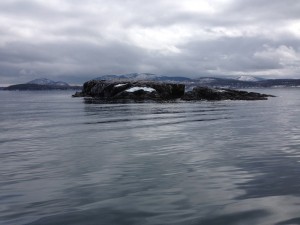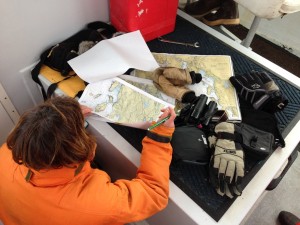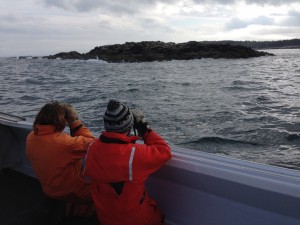June 30, 2015 at 9:26 am
Can you imagine wintering in Maine just so you can enjoy a milder winter? Seems somewhat misguided, but for purple sandpipers whose summers are spent on the arctic tundra, Maine must seem balmy.
[caption id="attachment_796" align="alignright" width="300"] snow-covered ledges like this provide a wintering home for purple sandpipers. A snow covered Acadia Park is in the background.[/caption]
These medium-sized shorebirds have the northernmost winter range of any shorebird. They migrate south to Maine in the fall and spend the winters on Maine’s rocky coast, picking through rockweed looking for its next meal of small crabs and other sea life.
Maine’s wildlife biologists keep an eye on these shorebirds as well as many others, and late this past winter, IFW wildlife biologist Lindsay Tudor led a group of biologists out on Penobscot bay, conducting a population survey to monitor trends in the purple sandpiper population. Maine is a key state for purple sandpipers, as it is estimated that 1/3 to ½ of the entire western Atlantic population winters in Maine.
[caption id="attachment_795" align="alignleft" width="300"]
snow-covered ledges like this provide a wintering home for purple sandpipers. A snow covered Acadia Park is in the background.[/caption]
These medium-sized shorebirds have the northernmost winter range of any shorebird. They migrate south to Maine in the fall and spend the winters on Maine’s rocky coast, picking through rockweed looking for its next meal of small crabs and other sea life.
Maine’s wildlife biologists keep an eye on these shorebirds as well as many others, and late this past winter, IFW wildlife biologist Lindsay Tudor led a group of biologists out on Penobscot bay, conducting a population survey to monitor trends in the purple sandpiper population. Maine is a key state for purple sandpipers, as it is estimated that 1/3 to ½ of the entire western Atlantic population winters in Maine.
[caption id="attachment_795" align="alignleft" width="300"] A lobster boat provides an excellent platform for counting purple sandpipers[/caption]
In late March and early April, IFW wildlife biologists, with support from the Maine Natural History Observatory and boat operator Dave Hiltz of the F/V Sure Thing, embarked on a 4-day boat survey of purple sandpiper wintering sites located in outer Penobscot Bay, Frenchman Bay and Blue Hill Bay.
[caption id="attachment_798" align="alignright" width="300"]
A lobster boat provides an excellent platform for counting purple sandpipers[/caption]
In late March and early April, IFW wildlife biologists, with support from the Maine Natural History Observatory and boat operator Dave Hiltz of the F/V Sure Thing, embarked on a 4-day boat survey of purple sandpiper wintering sites located in outer Penobscot Bay, Frenchman Bay and Blue Hill Bay.
[caption id="attachment_798" align="alignright" width="300"] Charting a course to small ledges and outcroppings require up to date charts and local knowledge of the waters.[/caption]
Counting these birds can be difficult, as purple sandpipers blend in well with the surrounding seaweed as they feed on small crustaceans and invertebrates. However, Fisherman/ biologist Dave Hiltz is an expert at maneuvering his 28-foot boat close enough to ledges for our biologists to get an accurate count.
Despite the rough seas, snow and drizzle, biologists recorded 2,845 purple sandpipers feeding and roosting on 160 rockweed and barnacle covered ledges. These numbers were slightly above the 2,771 birds that were counted in 2014, but still reflect a decline of nearly 50 percent from surveys that were conducted in 2004, with habitat loss suspected as most likely for the decline.
[caption id="attachment_799" align="alignleft" width="300"]
Charting a course to small ledges and outcroppings require up to date charts and local knowledge of the waters.[/caption]
Counting these birds can be difficult, as purple sandpipers blend in well with the surrounding seaweed as they feed on small crustaceans and invertebrates. However, Fisherman/ biologist Dave Hiltz is an expert at maneuvering his 28-foot boat close enough to ledges for our biologists to get an accurate count.
Despite the rough seas, snow and drizzle, biologists recorded 2,845 purple sandpipers feeding and roosting on 160 rockweed and barnacle covered ledges. These numbers were slightly above the 2,771 birds that were counted in 2014, but still reflect a decline of nearly 50 percent from surveys that were conducted in 2004, with habitat loss suspected as most likely for the decline.
[caption id="attachment_799" align="alignleft" width="300"] Floating survival suits are part of the uniform when conducting bird counts in Penobscot Bay during the winter[/caption]
Over the next few years, Maine will continue to monitor these birds in conjunction with biologists from Atlantic Canada. The continued monitoring will provide insight into trends which will help biologists better manage these migrating winter visitors to Maine.
[caption id="attachment_797" align="alignright" width="1024"]
Floating survival suits are part of the uniform when conducting bird counts in Penobscot Bay during the winter[/caption]
Over the next few years, Maine will continue to monitor these birds in conjunction with biologists from Atlantic Canada. The continued monitoring will provide insight into trends which will help biologists better manage these migrating winter visitors to Maine.
[caption id="attachment_797" align="alignright" width="1024"] The enclosed cabin of the lobster boat provides a brief respite from the elements.[/caption]
The enclosed cabin of the lobster boat provides a brief respite from the elements.[/caption]
 snow-covered ledges like this provide a wintering home for purple sandpipers. A snow covered Acadia Park is in the background.[/caption]
These medium-sized shorebirds have the northernmost winter range of any shorebird. They migrate south to Maine in the fall and spend the winters on Maine’s rocky coast, picking through rockweed looking for its next meal of small crabs and other sea life.
Maine’s wildlife biologists keep an eye on these shorebirds as well as many others, and late this past winter, IFW wildlife biologist Lindsay Tudor led a group of biologists out on Penobscot bay, conducting a population survey to monitor trends in the purple sandpiper population. Maine is a key state for purple sandpipers, as it is estimated that 1/3 to ½ of the entire western Atlantic population winters in Maine.
[caption id="attachment_795" align="alignleft" width="300"]
snow-covered ledges like this provide a wintering home for purple sandpipers. A snow covered Acadia Park is in the background.[/caption]
These medium-sized shorebirds have the northernmost winter range of any shorebird. They migrate south to Maine in the fall and spend the winters on Maine’s rocky coast, picking through rockweed looking for its next meal of small crabs and other sea life.
Maine’s wildlife biologists keep an eye on these shorebirds as well as many others, and late this past winter, IFW wildlife biologist Lindsay Tudor led a group of biologists out on Penobscot bay, conducting a population survey to monitor trends in the purple sandpiper population. Maine is a key state for purple sandpipers, as it is estimated that 1/3 to ½ of the entire western Atlantic population winters in Maine.
[caption id="attachment_795" align="alignleft" width="300"] A lobster boat provides an excellent platform for counting purple sandpipers[/caption]
In late March and early April, IFW wildlife biologists, with support from the Maine Natural History Observatory and boat operator Dave Hiltz of the F/V Sure Thing, embarked on a 4-day boat survey of purple sandpiper wintering sites located in outer Penobscot Bay, Frenchman Bay and Blue Hill Bay.
[caption id="attachment_798" align="alignright" width="300"]
A lobster boat provides an excellent platform for counting purple sandpipers[/caption]
In late March and early April, IFW wildlife biologists, with support from the Maine Natural History Observatory and boat operator Dave Hiltz of the F/V Sure Thing, embarked on a 4-day boat survey of purple sandpiper wintering sites located in outer Penobscot Bay, Frenchman Bay and Blue Hill Bay.
[caption id="attachment_798" align="alignright" width="300"] Charting a course to small ledges and outcroppings require up to date charts and local knowledge of the waters.[/caption]
Counting these birds can be difficult, as purple sandpipers blend in well with the surrounding seaweed as they feed on small crustaceans and invertebrates. However, Fisherman/ biologist Dave Hiltz is an expert at maneuvering his 28-foot boat close enough to ledges for our biologists to get an accurate count.
Despite the rough seas, snow and drizzle, biologists recorded 2,845 purple sandpipers feeding and roosting on 160 rockweed and barnacle covered ledges. These numbers were slightly above the 2,771 birds that were counted in 2014, but still reflect a decline of nearly 50 percent from surveys that were conducted in 2004, with habitat loss suspected as most likely for the decline.
[caption id="attachment_799" align="alignleft" width="300"]
Charting a course to small ledges and outcroppings require up to date charts and local knowledge of the waters.[/caption]
Counting these birds can be difficult, as purple sandpipers blend in well with the surrounding seaweed as they feed on small crustaceans and invertebrates. However, Fisherman/ biologist Dave Hiltz is an expert at maneuvering his 28-foot boat close enough to ledges for our biologists to get an accurate count.
Despite the rough seas, snow and drizzle, biologists recorded 2,845 purple sandpipers feeding and roosting on 160 rockweed and barnacle covered ledges. These numbers were slightly above the 2,771 birds that were counted in 2014, but still reflect a decline of nearly 50 percent from surveys that were conducted in 2004, with habitat loss suspected as most likely for the decline.
[caption id="attachment_799" align="alignleft" width="300"] Floating survival suits are part of the uniform when conducting bird counts in Penobscot Bay during the winter[/caption]
Over the next few years, Maine will continue to monitor these birds in conjunction with biologists from Atlantic Canada. The continued monitoring will provide insight into trends which will help biologists better manage these migrating winter visitors to Maine.
[caption id="attachment_797" align="alignright" width="1024"]
Floating survival suits are part of the uniform when conducting bird counts in Penobscot Bay during the winter[/caption]
Over the next few years, Maine will continue to monitor these birds in conjunction with biologists from Atlantic Canada. The continued monitoring will provide insight into trends which will help biologists better manage these migrating winter visitors to Maine.
[caption id="attachment_797" align="alignright" width="1024"] The enclosed cabin of the lobster boat provides a brief respite from the elements.[/caption]
The enclosed cabin of the lobster boat provides a brief respite from the elements.[/caption]
Categories